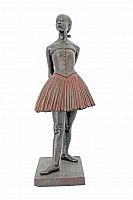BIOGRAPHY

James Butler, R.A.
(b. in London 1931)
James Butler was born in London in 1931 and lived most of his early life in Kent. Educated at Maidstone Grammar School and Maidstone School of Art, he then moved to London and studied for a further two years at St. Martin’s School of Art and finally the Royal College of Art.
He spent some ten years working as a professional stone carver with the Master Mason Gerald Giudici, and is responsible for many carvings that can be seen on buildings throughout London today, including the Queen Beasts in Kew Gardens. He taught sculpture and drawing at the City and Guilds of London Art School and was a visiting tutor to the Royal Academy Schools. James was first elected a member of the Royal Academy of Arts in 1964 and is a member of the Royal West of England Academy (R.W.A.), Fellow of the Royal Society of British Sculptors. (F.R.B.S.), and a Member of the Society of Portrait Sculptors.
BUTLER & DAUGHTER SASKIA
In the late 1960s and early 1970s, he worked with the Royal Shakespeare Company in Stratford-upon-Avon, creating statues for Julius Caesar, Coriolanus, and other productions. Incidental contacts with Madame Tussauds in London included The Beatles, the model Twiggy and the bull- fighter El Cordobes. For their Amsterdam museum, he made statues in plaster of two figures from Rembrandt’s Nightwatch, of Rembrandt himself, his son Titus and his two wives, Saskia van Uylenburg and Hendrickje Stoffels. It was as a result of these projects that James and Angie decided that their daughter – who was born shortly afterwards – should be called Saskia.
In 1972, James Butler was commissioned to make a portrait statue of President Jomo Kenyatta. The majestic 12-foot seated figure in the centre of Nairobi was a turning point in his career. He gave up teaching and became a full-time sculptor. The demand for public commissions has continued both in the U.K. and abroad.
BUTLER IN STUDIO
His large monumental figurative sculptures including the Rainbow Division Memorial, a pieta placed at the site of the Battle of the Croix Rouge Farm in Fère-en-Tardenois, France; the winged figure of Daedalus, a Memorial to the Fleet Air Arm which stands in the Embankment Gardens in London; the Memorial to the Green Howards, a seated figure of a contemplative soldier, described as ‘one of the most moving war memorials of our time’; and the figure of Field Marshall Earl Alexander of Tunis in Wellington Barracks, are just a few examples of his love for the military hero.
In contrast to the towering figures he is so well known for, he has designed for the Royal Mint, the Royal Seal of the Realm, the Jubilee coin and the 50 pence piece, commemorating Roger Bannister’s 4-minute mile.
Butler continues to work on commissions with undiminished enthusiasm, and on a much smaller scale, also spends much of his time producing sculptures of children, dancers and female nudes. His wife Angie and 5 daughters are often the source of his inspiration. He lives and works in Warwickshire.
I like the notion of spirit — spirit in the sense of active life, you are injecting some sort of living spirit into inert material, you inject into the objects you make a life of their own — the impression of a life outside your own.
– James Butler



